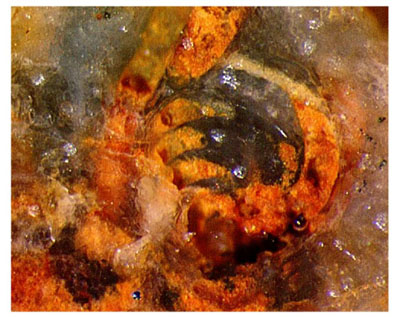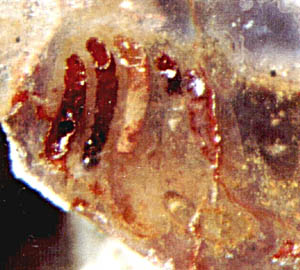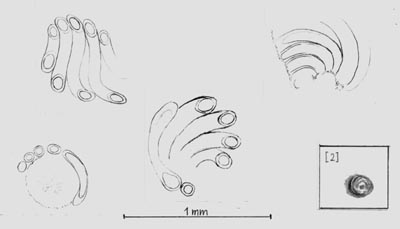Is there more than one charophyte alga in the
Rhynie chert ?
In view of the fact that no living plant can be regarded as a close
relative of one of the 7 "higher" terrestrial plants discovered
hitherto
in the Rhynie cherts, it is surprising that the green alga
Palaeonitella
looks rather similar to extant Nitella,
a water weed of
the stonewort clade, indicating that evolution was very slow in this
branch of charophyte alga for at least
400 million years. Palaeonitella
cranii was first described in 1921 [1] without the
characteristic
fruiting bodies (oogonia), which are called gyrogonites because of
their twisted appearance. The gyrogonites of Palaeonitella
were discovered only recently, which gave rise to a re-evaluation of
the species [2].
 In
this connection it is vexing to have got a chert sample with
abundant algae which look like
Palaeonitella (Fig.1) but show a feature never before seen
on Palaeonitella
cranii:
wound structures
(Figs. 2,3) which superficially resemble gyrogonites but are much
larger than those reported in [2], see Fig. 4. They are made up of
curved branches wound around an inner space or body of uncertain
nature. (It must be mentioned that, just as
with extant Nitella,
the stem and
branch segments
consist of only one big tube-like cell.)
In
this connection it is vexing to have got a chert sample with
abundant algae which look like
Palaeonitella (Fig.1) but show a feature never before seen
on Palaeonitella
cranii:
wound structures
(Figs. 2,3) which superficially resemble gyrogonites but are much
larger than those reported in [2], see Fig. 4. They are made up of
curved branches wound around an inner space or body of uncertain
nature. (It must be mentioned that, just as
with extant Nitella,
the stem and
branch segments
consist of only one big tube-like cell.)
Fig.1: Upper whorls of Palaeonitella,
silicified while
standing upright in the water. Incidentally, the big tube-like cells
making
up the plant remained hollow. Width of the picture 5mm.
Fig.3 (below right): Spiral object seen
on
a cut but not polished chert face;
width of the picture 1.1mm.
Photographs Figs.1,3: H. Sahm.


Fig.2 (right): View into a spiral object cut
nearly
lengthwise,
tube-like cells (or cast of their inner
hollow) seen in clear chalcedony;
width of the picture 0.85mm.
Fig.4 (below): Drawings of several
enclosures consisting of spirally wound branches, including those of
Figs.2 and 3, from the same chert sample, partially idealized for
better visibility. Note their big sizes compared
to the gyrogonite after [2].

In Fig.2, the oddly wound members fit closely
together on the left and
above, the apparent gaps being due to the fact that in some places only
the formerly hollow and later filled interior of the tube-like cells is
seen in optical contrast, but there are real gaps between the cells on
the right.
These chiral objects seem
to consist of
5 or 6
wound branches (= cells) whose arrangement does not show any symmetry
and does not form a closed space. Apparently the branches form some
kind of partial enclosure. As the size
of the chiral objects is comparable with that of
the antheridia described
in [2], they could possibly serve as protective baskets for antheridia,
a
feature not observed before.
Can P. cranii
be so
variable as
to bring forth such uncommon forms or is it a new species ? In view of
the current opinion that “there is no evidence of the presence of more
than one species of charophyte in the Rhynie chert” [2], p 451, this
would be interesting news.
Anyway, the wound structures illustrate how the gyrogonites could have
evolved from whorls of branches with a twist: In the course of
evolution,
the whorls protecting the oogonia apparently contracted into tightly
fitting capsules while those wound around the antheridia preserved an
ancient state of partial cover.
H.-J. Weiss
2005
Annotation 2015, 2016, 2017, 2018:
Several more finds of charophyte-like algae have not contributed to
answering open questions but have provided new ones, see Rhynie
Chert News 48,
73,
74, 89, 90, 93, 106, 129 138, 139, 141
[1] R.
Kidston, W.H. Lang:
On Old Red Sandstone plants … Part V,
Trans. Roy. Soc. Edinburgh 52(1921),
855-902.
[2] R.
Kelman, M. Feist, N.H. Trewin, H. Hass :
Charophyte algae from the Rhynie chert,
Trans. Roy. Soc. Edinburgh, Earth
Sciences 94(2004 for 2003), 445-455.
 |
 |
10 |


 In
this connection it is vexing to have got a chert sample with
abundant algae which look like
Palaeonitella (Fig.1) but show a feature never before seen
on Palaeonitella
cranii:
wound structures
(Figs. 2,3) which superficially resemble gyrogonites but are much
larger than those reported in [2], see Fig. 4. They are made up of
curved branches wound around an inner space or body of uncertain
nature. (It must be mentioned that, just as
with extant Nitella,
the stem and
branch segments
consist of only one big tube-like cell.)
In
this connection it is vexing to have got a chert sample with
abundant algae which look like
Palaeonitella (Fig.1) but show a feature never before seen
on Palaeonitella
cranii:
wound structures
(Figs. 2,3) which superficially resemble gyrogonites but are much
larger than those reported in [2], see Fig. 4. They are made up of
curved branches wound around an inner space or body of uncertain
nature. (It must be mentioned that, just as
with extant Nitella,
the stem and
branch segments
consist of only one big tube-like cell.)



